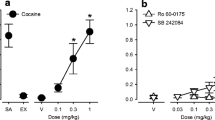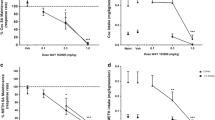Abstract
Rationale
The serotonin (5-hydroxytryptamine; 5-HT) 5-HT2 receptor (5-HT2R) family is an important regulator of the behavioral responsiveness to cocaine.
Objective
The present study is an analysis of the role of the 5-HT2R subtypes (5-HT2AR, 5-HT2BR, and 5-HT2CR) in the discriminative stimulus effects of cocaine.
Methods
Male Wistar rats were trained to discriminate cocaine (10 mg/kg) from saline in a two-lever, water-reinforced FR 20 task, and we investigated the ability of the 5-HT2AR antagonist 1(Z)-[2-(dimethylamino)ethoxyimino]-1(2-fluorophenyl)-3-(4-hydroxyphenyl)-2(E)-propene (SR 46349B), the 5-HT2BR antagonist N-(1-methyl-5-indolyl)-N′-(3-methyl-5-isothiazolyl) urea (SB 204741), and the 5-HT2CR antagonist [(+)-cis -4,5,7a,8,9,10,11,11a-octahydro-7H-10-methylindolo(1,7-bC)(2,6)naphthyridine (SDZ SER-082) to substitute for or to modulate the stimulus effects of cocaine.
Results
Pretreatment with SR 46349B (0.5–1 mg/kg) resulted in a rightward shift of the cocaine dose–response curve, while SDZ SER-082 (1 mg/kg) shifted the dose–response for cocaine to the left; SB 204741 (1–3 mg/kg) was inactive.
Conclusions
Our pharmacological analyses of selective antagonists of 5-HT2AR, 5-HT2BR, and 5-HT2CR indicate oppositional influence of 5-HT2AR and 5-HT2CR on the stimulus effects of cocaine and exclude a role for the 5-HT2BR. These data suggest that 5-HT2AR and 5-HT2CR may be important in modulating the subjective effects of cocaine in humans.



Similar content being viewed by others
References
Baxter G, Kennett G, Blaney F, Blackburn T (1995) 5-HT2 receptor subtypes: a family re-united? Trends Pharmacol Sci 16:105–110
Bubar MJ, McMahon LR, De Deurwaerdere P, Spampinato U, Cunningham KA (2003) Selective serotonin reuptake inhibitors enhance cocaine-induced locomotor activity and dopamine release in the nucleus accumbens. Neuropharmacology 44:342–353
Callahan PM, Cunningham KA (1995) Modulation of the discriminative stimulus properties of cocaine by 5-HT1B and 5-HT2C receptors. J Pharmacol Exp Ther 274:1414–1424
Callahan PM, De la Garza R 2nd, Cunningham KA (1994) Discriminative stimulus properties of cocaine: modulation by dopamine D1 receptors in the nucleus accumbens. Psychopharmacology 115:110–114
Clemett DA, Punhani T, Duxon MS, Blackburn TP, Fone KCF (2000) Immunohistochemical localisation of the 5-HT2C receptor protein in the rat CNS. Neuropharmacology 39:123–132
Cornea-Hebert V, Riad M, Wu C, Singh SK, Descarries L (1999) Cellular and subcellular distribution of the serotonin 5-HT2A receptor in the central nervous system of adult rat. J Comp Neurol 409:187–209
Dave KD, Harvey JA, Aloyo VJ (2002) A novel behavioral model that discriminates between 5-HT2A and 5-HT2C receptor activation. Pharmacol Biochem Behav 72:371–378
De Deurwaerdere P, Spampinato U (1999) Role of serotonin2A and serotonin2C receptor subtypes in the control of accumbal and striatal dopamine release elicited in vivo by dorsal raphe nucleus electrical stimulation. J Neurochem 73:1033–1042
Dekeyne A, Girardon S, Millan MJ (1999) Discriminative stimulus properties of the novel serotonin (5-HT)2C receptor agonist, RO 60-0175: a pharmacological analysis. Neuropharmacology 3:415–423
Dekeyne A, Iob L, Hautefaye P, Millan MJ (2002) The selective serotonin(2A) receptor antagonist, MDL 100,907, elicits a specific interoceptive cue in rats. Neuropsychopharmacology 26:552–556
Delfs JM, Schreiber L, Kelley AE (1990) Microinjection of cocaine into the nucleus accumbens elicits locomotor activation in the rat. J Neurosci 10:303–310
Di Chiara G (1995) The role of dopamine in drug abuse viewed from the perspective of its role in motivation. Drug Alcohol Depend 38:95–137
Di Giovanni G, De Deurwaerdere P, Di Mascio M, Di Matteo V, Esposito E, Spampinato U (1999) Selective blockade of serotonin-2C/2B receptors enhances mesolimbic and mesostriatal dopaminergic function: a combined in vivo electrophysiological and microdialysis study. Neuroscience 91:587–597
Di Matteo V, De Blasi A, Di Giulio C, Esposito E (2001) Role of 5-HT2C receptors in the control of central dopamine function. Trends Pharmacol Sci 22:229–232
Doherty MD, Pickel VM (2000) Ultrastructural localization of the serotonin 2A receptor in dopaminergic neurons in the ventral tegmental area. Brain Res 864:176–185
Drummond DC, Tiffany ST, Glautier S, Remington B (1995) Addictive behaviour: cue exposure theory and practice. Wiley, West Sussex, England
Duxon MS, Flanigan TP, Reavley AC, Baxter GS, Blackburn TP, Fone KCF (1997) Evidence for expression of the 5-hydroxytryptamine-2B receptor protein in the rat central nervous system. Neuroscience 76:323–329
Eberle-Wang K, Mikeladze Z, Uryu K, Chesselet M-F (1997) Pattern of expression of the serotonin2C receptor messenger RNA in the basal ganglia of adult rats. J Comp Neurol 384:233–247
Filip M, Cunningham KA (2002) Serotonin 5-HT(2C) receptors in nucleus accumbens regulate expression of the hyperlocomotive and discriminative stimulus effects of cocaine. Pharmacol Biochem Behav 71:745–756
Filip M, Cunningham KA (2003) Hyperlocomotive and discriminative stimulus effects of cocaine are under the control of serotonin(2C) (5-HT(2C)) receptors in rat prefrontal cortex. J Pharmacol Exp Ther 306:734–743
Filip M, Nowak E, Papla I (2001) On the role of serotonin 2A/2C receptors in sensitization to cocaine. J Physiol Pharmacol 52:471–481
Filip M, Bubar MJ, Cunningham KA (2004) Contribution of serotonin (5-HT) 5-HT2 receptor subtypes to the hyperlocomotor effects of cocaine: acute and chronic pharmacological analyses. J Pharmacol Exp Ther 310:1246–1254
Fletcher PJ, Grottick AJ, Higgins GA (2002) Differential effects of the 5-HT(2A) receptor antagonist M100907 and the 5-HT(2C) receptor antagonist SB242084 on cocaine-induced locomotor activity, cocaine self-administration and cocaine-induced reinstatement of responding. Neuropsychopharmacology 27:576–586
Fletcher PJ, Chintoh AF, Sinyard J, Higgins GA (2004) Injection of the 5-HT2C receptor agonist Ro 60-0175 into the ventral tegmental area reduces cocaine-induced locomotor activity and cocaine self-administration. Neuropsychopharmacology 29:308–318
Forbes IT, Jones GE, Murphy OE, Holland V, Baxter GS (1995) N-(1-methyl-5-indolyl)-N′-(3-methyl-5-isothiazolyl)urea: a novel, high-affinity 5-HT2B receptor antagonist. J Med Chem 38:855–857
Glusa E, Pertz HH (2000) Further evidence that 5-HT-induced relaxation of pig plumonar artery is mediated by endothelial 5-HT(2B) receptors. Br J Pharmacol 130:692–698
Gobert A, Rivet JM, Lejeune F, Newman-Tancredi A, Adhumeau-Auclair A, Nicolas JP, Cistarelli L, Melon C, Millan MJ (2000) Serotonin(2C) receptors tonically suppress the activity of mesocortical dopaminergic and adrenergic, but not serotonergic, pathways: a combined dialysis and electrophysiological analysis in the rat. Synapse 36:205–221
Hernandez M, Barahona MV, Simonsen U, Recio P, Rivera L, Martinez AC, Garcia-Sacristan A, Oransanz LM, Preito D (2003) Characterization of 5-hydroxytryptamine receptors mediating contraction in the pig isolated intravesical ureter. Br J Pharmacol 138:137–144
Higgins GA, Fletcher PJ (2003) Serotonin and drug reward: focus on 5-HT(2C) receptors. Eur J Pharmacol 480:151–162
Hoyer D, Hannon JP, Martin GR (2002) Molecular, pharmacological and functional diversity of 5-HT receptors. Pharmacol Biochem Behav 71:533–554
Kennett GA, Ainsworth K, Trail B, Blackburn TP (1997) BW 723C86, a 5-HT2B receptor agonist, causes hyperphagia and reduced grooming in rats. Neuropharmacology 36:233–239
Kennett GA, Bright F, Trail B, Baxter GS, Blackburn TP (1996) Effects of the 5-HT2B receptor agonist, BW 723C86, on three rat models of anxiety. Br J Pharmacol 117:1443–1448
Koe BK (1976) Molecular geometry of inhibitors of the uptake of catecholamines and serotonin in synaptosomal preparations of rat brain. J Pharmacol Exp Ther 199:649–661
Leysen JE, Pauwels PJ (1990) 5-HT2 receptors, roles and regulation. Ann N Y Acad Sci 600:183–191
Lucas G, Spampinato U (2000) Role of striatal serotonin2A and serotonin2C receptor subtypes in the control of in vivo dopamine outflow in the rat striatum. J Neurochem 74:693–701
Martin JR, Bos M, Jenck F, Moreau J-L, Mutel V, Sleight AJ, Wichmann J, Andrews JS, Berendsen HHG, Broekkamp CLE, Ruigt GSF, Kohler C, van Delft AML (1998) 5-HT2C receptor agonists: pharmacological characteristics and therapeutic potential. J Pharmacol Exp Ther 286:913–924
McCreary AC, Cunningham KA (1999) Effects of the 5-HT2C/2B antagonist SB 206553 on hyperactivity induced by cocaine. Neuropsychopharmacology 20:556–564
McKinzie DL, Rodd-Henricks ZA, Dagon CT, Murphy JM, McBride WJ (1999) Cocaine is self-administered into the shell region of the nucleus accumbens in Wistar rats. Ann N Y Acad Sci 877:788–791
McMahon LR, Cunningham KA (2001) Antagonism of 5-hydroxytryptamine2A receptors attenuates the behavioral effects of cocaine in rats. J Pharmacol Exp Ther 297:357–363
Meert TF, Janssen PAJ (1992) Ritanserin, a new therapeutic approach for drug abuse. Part 2: Effects on cocaine. Drug Dev Res 25:39–53
Millan MJ, Peglion JL, Lavielle G, Perrin-Monneyron S (1997) 5-HT2C receptors mediate penile erections in rats: actions of novel and selective agonists and antagonists. Eur J Pharmacol 325:9–12
Munzar P, Justinova Z, Kutkat SW, Goldberg SR (2002) Differential involvement of 5-HT2A receptors in the discriminative stimulus effects of cocaine and methamphetamine. Eur J Pharmacol 436:75–82
Navailles S, De Deurwaerdere P, Porras G, Spampinato U (2004) In vivo evidence that 5-HT2C receptor antagonist but not agonist modulates cocaine-induced dopamine outflow in the rat nucleus accumbens and striatum. Neuropsychopharmacology 29:319–326
Nozulak J, Kalkman HO, Floersheim P, Hoyer D, Schoeffter P, Buerki HR (1995) (+)-cis-4,5,7a,8,9,10,11,11a-Octahydro-7H-10-methylindolo[1,7-bc][2,6]-naphthyridine: a 5-HT2C/2B receptor antagonist with low 5-HT2A receptor affinity. J Med Chem 38:28–33
Peltier RL, Emmett-Oglesby MW, Thomas WH, Schenk S (1994) Failure of ritanserin to block the discriminative or reinforcing stimulus effects of cocaine. Pharmacol Biochem Behav 48:473–478
Rinaldi-Carmona M, Congy C, Santucci V, Simiand J, Gautret B, Neliat G, Labeeuw B, Le Fur G, Soubrie P, Breliere JC (1992) Biochemical and pharmacological properties of SR 46349B, a new potent and selective 5-hydroxytryptamine2 receptor antagonist. J Pharmacol Exp Ther 262:759–768
Schama KF, Howell LL, Byrd LD (1997) Serotonergic modulation of the discriminative-stimulus effects of cocaine in squirrel monkeys. Psychopharmacology 132:27–34
Schmidt CJ, Fadayel GM, Sullivan CK, Taylor VL (1992) 5-HT2 receptors exert a state-dependent regulation of dopaminergic function: studies with MDL 100,907 and the amphetamine analogue, 3,4-methylenedioxymethamphetamine. Eur J Pharmacol 223:65–74
Schuster CR, Johanson CE (1988) Relationship between the discriminative stimulus properties and subjective effects of drugs. Psychopharmacology 4:161–175
Schreiber R, Brocco M, Audinot V, Gobert A, Veiga S, Millan MJ (1995) 1-(2,5-Dimethoxy-4-iodophenyl)-2-aminopropane)-induced head-twitches in the rat are mediated by 5-hydroxytryptamine (5-HT)2A receptors: modulation by novel 5-HT2A/2C antagonists, D1 antagonists and 5-HT1A agonists. J Pharmacol Exp Ther 273:101–112
Sheskin D (2004) Handbook of parametric and nonparametric statistical procedures. Chapman & Hall/CRC, Boca Raton
Tallarida RJ, Murray RB (1987) Manual of pharmacological calculations with computer programs. Springer Berlin Heidelberg, New York
Walsh SL, Cunningham KA (1997) Serotonergic mechanisms involved in the discriminative stimulus, reinforcing, and subjective effects of cocaine. Psychopharmacology 130:41–58
Wise RA, Bozarth MA (1985) Brain mechanisms of drug reward and euphoria. Psychiatry Med 3:445–460
Acknowledgements
This research was supported by grants from the US–Poland Joint Commission Maria Sklodowska Curie Fund (MF and KAC), the National Institute on Drug Abuse [DA 06511 (KAC), DA 00260 (KAC), DA 15259 (MJB)], and the statutory activity of the Institute of Pharmacology Polish Academy of Sciences in Crakow (MF). The authors gratefully acknowledge the technical assistance of Ms. Ewa Nowak.
Author information
Authors and Affiliations
Corresponding author
Rights and permissions
About this article
Cite this article
Filip, M., Bubar, M.J. & Cunningham, K.A. Contribution of serotonin (5-HT) 5-HT2 receptor subtypes to the discriminative stimulus effects of cocaine in rats. Psychopharmacology 183, 482–489 (2006). https://doi.org/10.1007/s00213-005-0197-y
Received:
Accepted:
Published:
Issue Date:
DOI: https://doi.org/10.1007/s00213-005-0197-y




